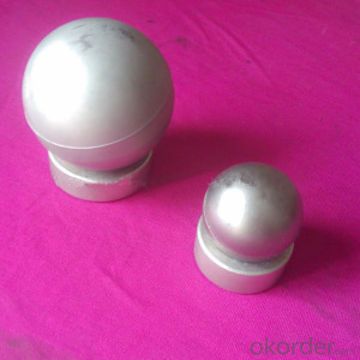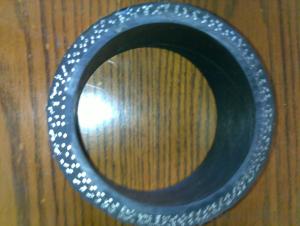High Precision Tinging Carbide Ball for Bearing
- Loading Port:
- Shanghai
- Payment Terms:
- TT OR LC
- Min Order Qty:
- 1 pc
- Supply Capability:
- 1000 pc/month
OKorder Service Pledge
OKorder Financial Service
You Might Also Like
Description:
Made by high purity carbide raw material, good abrasive resistance.
After accurate grinding and polishing, the friction factor of surface is very low.
High-precision technical equipment
Applications:
The carbide balls are widely used in where extreme hardness and wear resistance is required, such as bearings, ball screws, valves and flow meters, pen, spraying machines, pump, machinery parts, oil, hydrochloric acid lab, hardness measuring instrument and more high-end industry
Diameters:
Dia. 2, 5, 7, 8, 10, 12mm (or 5/8, 3/4, 15/16, 1-1/8, 1-1/4, 1-3/8, 1-1/16, 2-1/4") and more.
Quick details:
Place of origin: Zhuzhou, China
Chemical composition: WC + cobalt
Surface color: blanks ungrounded of grinding polished
MOQ:
Can be 100 pieces or 1kg
But the price will be a little bit high when the quantity is below 50kg or 2000USD
Packing:
First in plastic bag, 1 bag/paper box, 20 boxes/ctn
According to customer's demand
Sample:
Samples are available upon customers' request
Sample lead time is 7 days
Sample sent by DHL,UPS,FEDEX, EMS, China Post Airmail and more
Delivery lead time:
For standard types, delivery lead time is normally 20-25 days.
For nonstandard type or further processed type, delivery lead time is 25-35 days
For urgent needs, delivery lead time may be pushed by negotiation
Payment methods:
T/T, 30% deposit, balance payment before shipment
Other payment methods such as PayPal, Western Union, L/C are negotiable
Other services:
OEM and ODM are welcome
Customized designs welcomed
Experienced staffs will reply to your inquiry within 24 working hours
Grade numbers and application as below:
Grades | WC+ | CO+ | Density | Hardness | T.R.S | Metallographic analysis | Application |
YG6 | 94% | 6% | 14.6~15.0 | 91 | 1700 | A02B02C02 | widely used in all kinds of hardware industry, valve, bearing, die casting, punching, grinding, measurement. |
YG6X | 94% | 6% | 14.6~15.0 | 92 | 1450 | A02B02C02 | widely used in all kinds of hardware industry, valve, bearing, die casting, punching, grinding, measurement, chemical industry, petroleum, military |
YG8 | 92% | 8% | 14.4~14.8 | 89 | 1800 | A02B02C02 | widely used in valves, bearings, die casting, punching, grinding,measurement, hardness tester, petroleum, chemical industry, aeronautics and astronautics. |


- Q: What are the different types of concrete pump wear rings?
- There are primarily two types of concrete pump wear rings: stationary wear rings and rotating wear rings. Stationary wear rings are fixed in position and provide a surface for the rotating wear ring to slide against. Rotating wear rings, on the other hand, are designed to spin with the impeller and prevent direct contact between the impeller and stationary wear ring, reducing friction and extending the life of the pump.
- Q: How often should hopper grate clamps be inspected or replaced in a concrete pump?
- Hopper grate clamps in a concrete pump should be inspected regularly, preferably on a monthly basis, to ensure they are in proper working condition. However, the frequency of inspection may vary depending on the usage and operating conditions of the concrete pump. If the concrete pump is used extensively or subjected to harsh environments, more frequent inspections may be necessary, such as every two weeks or even weekly. On the other hand, if the pump is used less frequently or operates in less demanding conditions, inspections can be done less frequently, such as every two to three months. The purpose of these inspections is to identify any signs of wear, damage, or deterioration in the hopper grate clamps. Any loose or worn-out clamps should be promptly replaced to prevent accidents or disruptions during concrete pumping operations. It is crucial to prioritize safety and ensure that the hopper grate clamps are in good condition to secure the hopper grate effectively and prevent any unwanted material spillage. Regular inspections and timely replacements of hopper grate clamps will help maintain the efficiency and reliability of the concrete pump, ensuring uninterrupted operation and minimizing the risk of any potential issues.
- Q: What are the performance characteristics of concrete pump?
- The utility model has the function of anti pumping, is favorable for removing the pipe stoppage in time, and can be shut down for a short time to be expected
- Q: What are the preventive measures for concrete pump?
- In order to ensure the continuity of pumping concrete operation, and ensure the quality of concrete pouring, the interval between the operations should not be too long, so as to prevent clogging.
- Q: What are the different types of concrete pump hopper cylinders?
- There are several different types of concrete pump hopper cylinders that are commonly used in the construction industry. These cylinders play a crucial role in the operation of concrete pumps by providing the necessary pressure and force to move the concrete through the system. One type of concrete pump hopper cylinder is the single-acting cylinder. This type of cylinder operates by using hydraulic pressure to extend the piston rod, which in turn pushes the concrete out of the hopper and into the pumping system. Single-acting cylinders are known for their simplicity and reliability, making them a popular choice for many construction projects. Another type of concrete pump hopper cylinder is the double-acting cylinder. As the name suggests, this type of cylinder operates in both directions, allowing for a more efficient and powerful pumping process. Double-acting cylinders are capable of pushing the concrete out of the hopper during the extension stroke and pulling the piston rod back during the retraction stroke, resulting in a higher pumping capacity and increased productivity. Additionally, there are also different sizes and capacities of concrete pump hopper cylinders available, ranging from smaller cylinders suitable for smaller construction projects to larger cylinders capable of handling heavy-duty pumping operations. The choice of cylinder size depends on factors such as the volume of concrete to be pumped, the distance and height of the pumping location, and the specific requirements of the project. In conclusion, the different types of concrete pump hopper cylinders include single-acting cylinders and double-acting cylinders. Each type has its own advantages and is suitable for different construction applications. The size and capacity of the cylinder should be chosen based on the specific needs of the project. Ultimately, selecting the right type of cylinder is crucial for ensuring efficient and effective concrete pumping operations.
- Q: How can a malfunctioning control box affect the pump's operation?
- A malfunctioning control box can have various negative effects on the operation of a pump. Firstly, it can result in an inaccurate or inconsistent control of the pump's functions. This means that the pump may not start or stop at the desired times or operate at the correct speed, leading to inefficient or inadequate pumping. Additionally, a malfunctioning control box may cause electrical issues, leading to power fluctuations or even power surges. These electrical problems can cause damage to the pump's motor or other components, leading to premature wear and tear or complete failure. Furthermore, a malfunctioning control box can also disrupt the communication between the pump and other systems. This can affect the pump's ability to receive or send signals, resulting in a lack of coordination with other equipment or systems that rely on the pump's operation. This lack of coordination can lead to system failures or disruptions in the overall process or operation that the pump supports. In summary, a malfunctioning control box can have detrimental effects on the pump's operation including inaccurate control, electrical issues, and disruption of communication with other systems. It is crucial to regularly inspect and maintain control boxes to prevent these malfunctions and ensure the reliable and efficient operation of pumps.
- Q: What are the different types of concrete pump hopper agitator motors?
- There are generally two types of concrete pump hopper agitator motors: electric motors and hydraulic motors. Electric motors are powered by electricity and are commonly used in smaller and portable concrete pumps. Hydraulic motors, on the other hand, are driven by hydraulic power generated by the concrete pump itself and are typically used in larger and stationary concrete pumps.
- Q: How does a hopper agitator blade ensure smooth concrete flow?
- To guarantee a seamless flow of concrete, a hopper agitator blade is employed to mix and disintegrate any clumps or air pockets in the concrete mixture. Specifically designed to be positioned inside the hopper, the blade rotates and agitates the concrete, ensuring a homogeneous and steady state. While in rotation, the blade disperses any settled aggregates at the hopper's base, preventing blockages or uneven distribution during the pouring procedure. This uninterrupted mixing action guarantees that the concrete remains well-blended and effortlessly pours out of the hopper. Furthermore, the agitator blade aids in breaking up any air bubbles that may have formed within the concrete mixture. These air bubbles can compromise the structural integrity of the concrete and lead to an uneven final appearance. By agitating the concrete, the blade effectively releases trapped air, promoting a consistently dense mixture. In essence, a hopper agitator blade guarantees a seamless flow of concrete by effectively blending the mixture, breaking apart any clumps or air pockets, and fostering a uniform composition. This ensures that the concrete pours smoothly and evenly during the pouring process, resulting in a top-notch end product.
- Q: How do I properly adjust and control flow rates in concrete pump spare parts?
- To properly adjust and control flow rates in concrete pump spare parts, you should start by examining the pump's manual and understanding its specific settings and controls. It's important to ensure that all valves and levers are in the correct position and functioning properly. Additionally, you can adjust the flow rate by manipulating the stroke length and speed of the pump. Experimenting with these settings while monitoring the flow rate will help you achieve the desired results. Regular maintenance and cleaning of the pump parts are also crucial to ensure smooth flow control.
- Q: How do I maintain the performance of concrete pump spare parts in extreme weather conditions?
- To ensure the efficiency and longevity of your equipment, it is crucial to maintain the performance of concrete pump spare parts in extreme weather conditions. Consider the following tips: 1. Conduct regular inspections to detect signs of wear and tear early on. Extreme weather can accelerate part deterioration, so staying vigilant is important. 2. Keep spare parts clean to prevent clogging or damage caused by dirt, debris, or contaminants that may accumulate in extreme weather conditions. 3. Use appropriate lubrication for smooth functioning. Opt for lubricants designed for extreme weather, with high viscosity and resistance to temperature fluctuations. 4. Protect spare parts from direct exposure to extreme heat or freezing temperatures by using covers or enclosures. 5. Store spare parts in a dry, temperature-controlled environment when not in use. Extreme weather can cause expansion or contraction, potentially leading to damage. Controlled storage helps maintain integrity and performance. 6. Monitor and replace worn-out parts in a timely manner to maintain performance. Extreme weather conditions can accelerate wear and tear, so proactive replacement is crucial. 7. Consult the manufacturer for specific requirements on maintaining spare parts in extreme weather. They can offer expert advice and guidance for optimal performance. By following these tips, you can effectively preserve the performance of concrete pump spare parts in extreme weather conditions, ensuring smooth and efficient equipment operation.
Send your message to us
High Precision Tinging Carbide Ball for Bearing
- Loading Port:
- Shanghai
- Payment Terms:
- TT OR LC
- Min Order Qty:
- 1 pc
- Supply Capability:
- 1000 pc/month
OKorder Service Pledge
OKorder Financial Service
Similar products
Hot products
Hot Searches
Related keywords



























